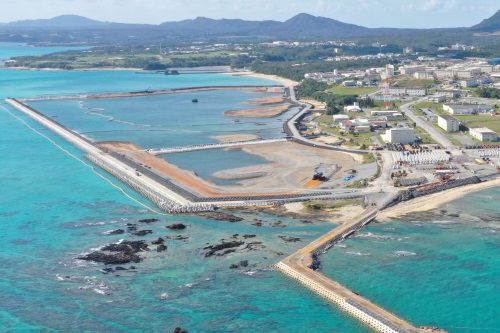Ministry of Defense postpones two Henoko-related construction projects to focus on soft ground in Henoko Bay

Construction progressing along the Henoko coast in Nago. December 8, 2019 near Camp Schwab (photograph taken by drone)
January 5, 2020 Ryukyu Shimpo
Tokyo – The Ministry of Defense (MoD) has decided to postpone two projects appropriated for 2019 related to the new base construction in Henoko, Nago City, such as the redirection of a waterway that runs through Camp Schwab.
This was done in order to prioritize the necessary improvement of the soft ground that will serve as the foundation of the new base.
The budget for the postponed projects (approximately 16 billion yen) will instead be put towards land acquisition on Mageshima (Nishinoomote City) in Kagoshima prefecture, one of the candidate sites for relocating the U.S. military’s field carrier landing practice (FCLP), which involves Navy aircraft landing on aircraft carriers.
Okinawa has indicated a policy of not consenting to the change in plans regarding the fortification of the soft ground in Henoko bay, and is unable to forecast when the two postponed projects will begin.
The two postponed projects are the redirection of Misya River, the mouth of which will be blocked by land reclamation, and the installation of a belt conveyer for carrying the sediment collected from Henoko Dam for land reclamation.
Both projects require the cooperation of Nago’s mayor, and the MoD had appropriated the relevant funds in hopes of earning the cooperation of Mayor Taketoyo Toguchi, who has shown sympathy towards the Henoko relocation.
The government planned the two projects on the Oura Bay side. However, it was forced to prioritize measures to improve the soft ground and postponed the execution of the related expenses of 12.5 billion yen included in the FY2019 budget.
A Ministry of Defense official said, “We have to obtain an approval from the prefectural government to revise the plan (necessary procedures for ground improvement).”
Meanwhile, in November, 2019 the Japanese government adopted an outline for a plan to use 16 billion yen to acquire the land on Mageshima, of which 99% is owned by development companies based in Tokyo.
Both the Henoko construction and Mageshima development are expenses related to the reorganization of the U.S. forces stationed in Japan, so the MoD figured they could re-appropriate the unused funds within this framework for the Mageshima land acquisition.
In December of 2019, over 60% of this land was converted into state-owned land.
However, the government originally proposed only 4.5 billion yen for the purchase of Mageshima, and there are many unclear aspects as to why the purchase price has tripled.
In the report issued by the cabinet in December, they did not clarify the basis for their new calculations, only stating that “There was the risk of impediments in the process of buying the land,” and pushed through with the land acquisition without first deliberating the budget in the Diet.
(English translation by T&CT and Sam Grieb)
Previous Article:Editorial: Welcoming the New Year – Toward a Functioning Democracy
Next Article:Ryuichi Sakamoto visits Henoko base construction site, says there is no justification for destroying nature to build base
[Similar Articles]
- Postponement of seawall construction in Oura Bay for FY2020 on may be result of soft seabed
- Henoko land reclamation expenses expected to reach 2.5 trillion yen
- Cost of land reclamation in two zones in Henoko rise by 13.5 billion yen to 51.3 billon yen total
- Editorial:With Henoko construction costs expected to reach 930 billion yen, land reclamation must be stopped at once
- Ministry of Defense allocates one billion yen for the deployment of Self-Defense Forces to Yonaguni Island
 Webcam(Kokusai Street)
Webcam(Kokusai Street)


